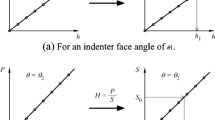Abstract
A method for predicting the ultimate tensile strength (S u ) of a material from Brinell-type hardness tests is described for several metals including steel, aluminum, and copper alloys. The prediction of S u is based on a consistent relationship between S u and a material’s hardness coefficient, K d . A simple experimental procedure for determining K d from indentation-hardness test data is presented. The relationship between S u and K d is found to be 1/3 for all cubic metals. Comparisons between predicted and experimentally determined values of S u are made for each of the materials studied, and sources of error between the two S u values are discussed.
Similar content being viewed by others
References
J.E. Shigley and L.D. Mitchell: Mechanical Engineering Design, McGraw-Hill, New York, NY, 1983.
D. Tabor: The Hardness of Metals, Clarendon Press, Oxford, United Kingdom, 1951.
H. O’Neill: Hardness Measurement of Metals and Alloys, Chapman & Hall, London, 1967.
Author information
Authors and Affiliations
Rights and permissions
About this article
Cite this article
Datsko, J., Hartwig, L. & McClory, B. On the tensile strength and hardness relation for metals. J. of Materi Eng and Perform 10, 718–722 (2001). https://doi.org/10.1361/105994901770344601
Received:
Revised:
Issue Date:
DOI: https://doi.org/10.1361/105994901770344601



